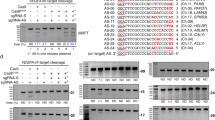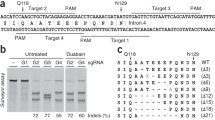Abstract
Isolation of genetically modified cells generated by designed nucleases are challenging, since they are often phenotypically indistinguishable from their parental cells. To efficiently enrich genetically modified cells, we developed two dual-reporter surrogate systems, namely NHEJ-RPG and SSA-RPG based on NHEJ and SSA repair mechanisms, respectively. Repair and enrichment efficiencies of these two systems were compared using different nucleases. In both CRISPR-Cas9- and ZFNs-induced DSB repair studies, we found that the efficiency and sensitivity of the SSA-RPG reporter with direct repeat length more than 200 bp were much higher than the NHEJ-RPG reporter. By utilizing the SSA-RPG reporter, we achieved the enrichment for indels in several endogenous loci with 6.3- to 34.8-fold of non-selected cells. Thus, the highly sensitive SSA-RPG reporter can be used for activity validation of designed nucleases and efficient enrichment of genetically modified cells. Besides, our systems offer alternative enrichment choices either by puromycin selection or FACS.




Similar content being viewed by others
References
Segal DJ, Meckler JF (2013) Genome engineering at the dawn of the golden age. Annu Rev Genom Hum G 14:135–158. doi:10.1146/annurev-genom-091212-153435
Cathomen T, Joung JK (2008) Zinc-finger nucleases: the next generation emerges. Mol Ther 16(7):1200–1207. doi:10.1038/Mt.2008.114
Pennisi E (2012) The tale of the TALEs. Science 338(6113):1408–1411
Horvath P, Barrangou R (2010) CRISPR/Cas, the immune system of bacteria and archaea. Science 327(5962):167–170. doi:10.1126/science.1179555
Wiedenheft B, Sternberg SH, Doudna JA (2012) RNA-guided genetic silencing systems in bacteria and archaea. Nature 482(7385):331–338. doi:10.1038/Nature10886
Jinek M, Chylinski K, Fonfara I, Hauer M, Doudna JA, Charpentier E (2012) A programmable dual-RNA-guided DNA endonuclease in adaptive bacterial immunity. Science 337(6096):816–821. doi:10.1126/science.1225829
Cong L, Ran FA, Cox D, Lin SL, Barretto R, Habib N, Hsu PD, Wu XB, Jiang WY, Marraffini LA, Zhang F (2013) Multiplex genome engineering using CRISPR/Cas systems. Science 339(6121):819–823. doi:10.1126/science.1231143
Friedland AE, Tzur YB, Esvelt KM, Colaiacovo MP, Church GM, Calarco JA (2013) Heritable genome editing in C. elegans via a CRISPR-Cas9 system. Nat Methods 10(8):741. doi:10.1038/Nmeth.2532
Gratz SJ, Cummings AM, Nguyen JN, Hamm DC, Donohue LK, Harrison MM, Wildonger J, O’Connor-Giles KM (2013) Genome engineering of drosophila with the CRISPR RNA-guided Cas9 nuclease. Genetics 194(4):1029. doi:10.1534/genetics.113.152710
Hwang WY, Fu YF, Reyon D, Maeder ML, Tsai SQ, Sander JD, Peterson RT, Yeh JRJ, Joung JK (2013) Efficient genome editing in zebrafish using a CRISPR-Cas system. Nat Biotechnol 31(3):227–229. doi:10.1038/Nbt.2501
Mali P, Yang LH, Esvelt KM, Aach J, Guell M, DiCarlo JE, Norville JE, Church GM (2013) RNA-guided human genome engineering via Cas9. Science 339(6121):823–826. doi:10.1126/science.1232033
Kim H, Um E, Cho SR, Jung C, Kim H, Kim JS (2011) Surrogate reporters for enrichment of cells with nuclease-induced mutations. Nat Methods 8(11):941–943. doi:10.1038/nmeth.1733
Perez EE, Wang JB, Miller JC, Jouvenot Y, Kim KA, Liu O, Wang N, Lee G, Bartsevich VV, Lee YL, Guschin DY, Rupniewski I, Waite AJ, Carpenito C, Carroll RG, Orange JS, Urnov FD, Rebar EJ, Ando D, Gregory PD, Riley JL, Holmes MC, June CH (2008) Establishment of HIV-1 resistance in CD4(+) T cells by genome editing using zinc-finger nucleases. Nat Biotechnol 26(7):808–816. doi:10.1038/Nbt1410
Kim HJ, Lee HJ, Kim H, Cho SW, Kim JS (2009) Targeted genome editing in human cells with zinc finger nucleases constructed via modular assembly. Genome Res 19(7):1279–1288. doi:10.1101/gr.089417.108
Kim H, Kim MS, Wee G, Lee CI, Kim H, Kim JS (2013) Magnetic separation and antibiotics selection enable enrichment of cells with ZFN/TALEN-induced mutations. PLoS One. doi:10.1371/journal.pone.0056476
Ramakrishna S, Cho SW, Kim S, Song M, Gopalappa R, Kim JS, Kim H (2014) Surrogate reporter-based enrichment of cells containing RNA-guided Cas9 nuclease-induced mutations. Nat Commun. doi:10.1038/Ncomms4378
Kim YH, Ramakrishna S, Kim H, Kim JS (2014) Enrichment of cells with TALEN-induced mutations using surrogate reporters. Methods 69(1):108–117. doi:10.1016/j.ymeth.2014.04.012
Wang C, Lees-Miller SP (2013) Detection and repair of ionizing radiation-induced DNA double strand breaks: new developments in nonhomologous end joining. Int J Radiat Oncol Biol Phys 86(3):440–449. doi:10.1016/j.ijrobp.2013.01.011
Lieber MR (2010) The mechanism of double-strand DNA break repair by the nonhomologous DNA end-joining pathway. Annu Rev Biochem 79:181–211. doi:10.1146/annurev.biochem.052308.093131
Ramsden DA, Gellert M (1998) Ku protein stimulates DNA end joining by mammalian DNA ligases: a direct role for Ku in repair of DNA double-strand breaks. EMBO J 17(2):609–614. doi:10.1093/emboj/17.2.609
Fishman-Lobell J, Rudin N, Haber JE (1992) Two alternative pathways of double-strand break repair that are kinetically separable and independently modulated. Mol Cell Biol 12(3):1292–1303
Lin FL, Sperle K, Sternberg N (1984) Model for homologous recombination during transfer of DNA into mouse L cells: role for DNA ends in the recombination process. Mol Cell Biol 4(6):1020–1034
Lin FL, Sperle K, Sternberg N (1990) Repair of double-stranded DNA breaks by homologous DNA fragments during transfer of DNA into mouse L cells. Mol Cell Biol 10(1):113–119
Maryon E, Carroll D (1991) Characterization of recombination intermediates from DNA injected into Xenopus laevis oocytes: evidence for a nonconservative mechanism of homologous recombination. Mol Cell Biol 11(6):3278–3287
Liu JG, Gong L, Chang CQ, Liu C, Peng JR, Chen J (2012) Development of novel visual-plus quantitative analysis systems for studying DNA double-strand break repairs in zebrafish. J Genet Genomics 39(9):489–502. doi:10.1016/j.jgg.2012.07.009
Knoll A, Fauser F, Puchta H (2014) DNA recombination in somatic plant cells: mechanisms and evolutionary consequences. Chromosome Res 22(2):191–201. doi:10.1007/s10577-014-9415-y
Iyama T, Wilson DM (2013) DNA repair mechanisms in dividing and non-dividing cells. DNA Repair 12(8):620–636. doi:10.1016/j.dnarep.2013.04.015
Bennardo N, Cheng A, Huang N, Stark JM (2008) Alternative-NHEJ is a mechanistically distinct pathway of mammalian chromosome break repair. PLoS Genet. doi:10.1371/journal.pgen.1000110
Jeggo PA (1998) Identification of genes involved in repair of DNA double-strand breaks in mammalian cells. Radiat Res 150(5 Suppl):S80–S91
Kuhar R, Gwiazda KS, Humbert O, Mandt T, Pangallo J, Brault M, Khan I, Maizels N, Rawlings DJ, Scharenberg AM, Certo MT (2014) Novel fluorescent genome editing reporters for monitoring DNA repair pathway utilization at endonuclease-induced breaks. Nucleic Acids Res. doi:10.1093/nar/gkt872
Preston CR, Flores CC, Engels WR (2006) Differential usage of alternative pathways of double-strand break repair in Drosophila. Genetics 172(2):1055–1068. doi:10.1534/genetics.105.050138
Perez C, Guyot V, Cabaniols JP, Gouble A, Micheaux B, Smith J, Leduc S, Paques F, Duchateau P (2005) Factors affecting double-strand break-induced homologous recombination in mammalian cells. Biotechniques 39(1):109–115. doi:10.2144/05391gt01
Ira G, Haber JE (2002) Characterization of RAD51-independent break-induced replication that acts preferentially with short homologous sequences. Mol Cell Biol 22(18):6384–6392. doi:10.1128/Mcb.22.18.6384-6392.2002
Sugawara N, Ira G, Haber JE (2000) DNA length dependence of the single-strand annealing pathway and the role of Saccharomyces cerevisiae RAD59 in double-strand break repair. Mol Cell Biol 20(14):5300–5309. doi:10.1128/Mcb.20.14.5300-5309.2000
Ren C, Yan Q, Zhang Z (2014) Minimum length of direct repeat sequences required for efficient homologous recombination induced by zinc finger nuclease in yeast. Mol Biol Rep. doi:10.1007/s11033-014-3579-6
Wang L, Lin J, Zhang T, Xu K, Ren C, Zhang Z (2013) Simultaneous screening and validation of effective zinc finger nucleases in yeast. PLoS One 8(5):e64687. doi:10.1371/journal.pone.0064687
Ren C, Yan Q, Zhang Z (2014) Minimum length of direct repeat sequences required for efficient homologous recombination induced by zinc finger nuclease in yeast. Mol Biol Rep 41(10):6939–6948. doi:10.1007/s11033-014-3579-6
Xu K, Ren C, Liu Z, Zhang T, Zhang T, Li D, Wang L, Yan Q, Guo L, Shen J, Zhang Z (2014) Efficient genome engineering in eukaryotes using Cas9 from Streptococcus thermophilus. Cell Mol Life Sci CMLS. doi:10.1007/s00018-014-1679-z
Zhang C, Xu K, Hu L, Wang L, Zhang T, Ren C, Zhang Z (2014) A suicidal zinc finger nuclease expression coupled with a surrogate reporter for efficient genome engineering. Biotechnol Lett. doi:10.1007/s10529-014-1690-3
Morton J, Davis MW, Jorgensen EM, Carroll D (2006) Induction and repair of zinc-finger nuclease-targeted double-strand breaks in Caenorhabditis elegans somatic cells. P Natl Acad Sci USA 103(44):16370–16375. doi:10.1073/pnas.0605633103
Gasiunas G, Barrangou R, Horvath P, Siksnys V (2012) Cas9-crRNA ribonucleoprotein complex mediates specific DNA cleavage for adaptive immunity in bacteria. P Natl Acad Sci USA 109(39):E2579–E2586. doi:10.1073/pnas.1208507109
Szymczak AL, Workman CJ, Wang Y, Vignali KM, Dilioglou S, Vanin EF (2004) Vignali DAA (2004) Correction of multi-gene deficiency in vivo using a single ‘self-cleaving’ 2A peptide-based retroviral vector (vol 22, pg 589). Nat Biotechnol 22(12):1590. doi:10.1038/nbt1204-1590b
Cradick TJ, Ambrosini G, Iseli C, Bucher P, McCaffrey AP (2011) ZFN-Site searches genomes for zinc finger nuclease target sites and off-target sites. BMC Bioinform. doi:10.1186/1471-2105-12-152
Guo J, Gaj T, Barbas CF 3rd (2010) Directed evolution of an enhanced and highly efficient FokI cleavage domain for zinc finger nucleases. J Mol Biol 400(1):96–107. doi:10.1016/j.jmb.2010.04.060
Seyfang A, Jin JHQ (2004) Multiple site-directed mutagenesis of more than 10 sites simultaneously and in a single round. Anal Biochem 324(2):285–291. doi:10.1016/J.Ab.2003.10.012
Guschin DY, Waite AJ, Katibah GE, Miller JC, Holmes MC, Rebar EJ (2010) A rapid and general assay for monitoring endogenous gene modification. Methods Mol Biol 649:247–256. doi:10.1007/978-1-60761-753-2_15
Acknowledgments
The authors would like to thank all the colleagues in Professor Zhang’s lab for their excellent technical assistance and helpful discussions. This work was supported by grants from National Natural Science Foundation of China (NSFC) [31171186], National Science and Technology Major Project of China [2014ZX0801009B] and Natural Science Basic Research Plan in Shaanxi Province of China [2013JQ3009].
Conflict of interest
The authors declare that no competing interests exist.
Author information
Authors and Affiliations
Corresponding author
Additional information
C. Ren and K. Xu contributed equally to this work and should be regarded as joint First Authors.
Electronic supplementary material
Below is the link to the electronic supplementary material.
Rights and permissions
About this article
Cite this article
Ren, C., Xu, K., Liu, Z. et al. Dual-reporter surrogate systems for efficient enrichment of genetically modified cells. Cell. Mol. Life Sci. 72, 2763–2772 (2015). https://doi.org/10.1007/s00018-015-1874-6
Received:
Revised:
Accepted:
Published:
Issue Date:
DOI: https://doi.org/10.1007/s00018-015-1874-6




